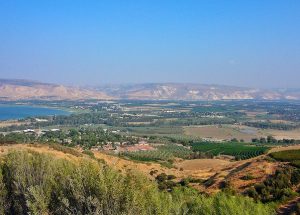by Maj. Gen. (res.) Gershon Hacohen
Beyond its unquestionable vitality for Israel’s security, the Jordan Valley in its full geographical scope can accommodate millions of Israelis and national infrastructure

A view across the Jordan Valley, looking down on the Sea of Galilee. Photo by Cycling Man via Flickr CC
BESA Center Perspectives Paper No. 1,291, September 16, 2019
EXECUTIVE SUMMARY: Beyond its
unquestionable vitality for Israel’s security, the Jordan Valley in its
full geographical scope can accommodate millions of Israelis and
national infrastructure that cannot be compressed into the coastal
plain. If PM Netanyahu’s declaration of sovereignty is not immediately
borne out by a surge of building and focused governmental support, it
will sputter and die.
PM Netanyahu’s promise to apply sovereignty to the
Jordan Valley is worthy of praise. The reasons for doing so were
already evident to PM Levi Eshkol in the immediate wake of the 1967 the
Six-Day War, and were fully fleshed out in the Allon Plan. As the plan
stated: “The eastern border of the state of Israel must be the Jordan
River and a line that crosses the Dead Sea in the middle…. We must add
to the country—as an inseparable part of its sovereignty—a strip
approximately 10-15 kilometers wide, along the Jordan Valley.”
The plan was presented to the government headed by
Eshkol, who, with his Mapai mindset, chose to introduce it without
putting it to a vote. Typically for those days, the plan moved
immediately to the implementation stage, and a settlement infrastructure
was built that has existed ever since. In line with the plan, the Allon
Road was paved and the Jordan Valley communities were built along Road
90 and the Allon Road.
In the Knesset debate on the Oslo Interim
Agreement in October 1995, PM Rabin, about a month before his
assassination, outlined his position and stated: “The security border of
the State of Israel will be located in the Jordan Valley, in the
broadest meaning of that term.” The notion of applying sovereignty to
the Jordan Valley has always enjoyed a broad national consensus.
It was PM Ehud Barak (1999-2001) who breached that
consensus for the first time. Since then, his relinquishment of the
Jordan Valley has been incorporated into the Clinton Parameters
(December 2000) and into the basic international conception of the peace
process, which views it as a cornerstone of the two-state solution.
After the peace treaty with Jordan in 1994, and
especially after the collapse of Saddam Hussein’s army in the Iraq War
(2003), it has been increasingly argued that the threat of an eastern
front had passed and controlling the Jordan Valley was no longer crucial
to Israel’s security. As former head of Central Command Maj. Gen.
(res.) Amram Mitzna put it: “When long-range missiles can be fired,
strategic depth is of no importance. Agreements will give us more
security than strategic depth.”
Even then, this argument was divorced from a basic
understanding of the phenomenon of war. Since that time, in light of
the lessons of the Palestinian terror war (euphemized as the al-Aqsa
Intifada), the upheaval known as the “Arab Spring,” Hezbollah’s enormous
missile arsenal, and the strengthening of the rocket/missile threat and
of Hamas itself, as well as Tehran’s growing expansionism, which could
deploy Shiite militias in a new front along Israel’s main national
artery (Highway 6), the Jordan Valley’s status as a vital Israeli
security interest has only increased.
Most advocates of a Palestinian state say it will
be demilitarized and unable to threaten Israel’s security. During the
Oslo Process years, the PLO feigned acceptance of demilitarization,
signing a number of agreements to this specific effect, only to
flagrantly violate them as the West Bank and Gaza were transformed into
hothouses of terror. The failure of the UN forces in Lebanon to carry
out Resolution 1701 ending the 2006 Lebanon War, which was supposed to
prevent Hezbollah from arming itself in the south of that country, shows
why proposals to deploy international forces in a similar role in the
Jordan Valley cannot guarantee a true demilitarization. Thus the Jordan
Valley, as a buffer zone controlled by the IDF, is an existential
necessity when it comes to Israel’s security.
In addition to the security issue, the Jordan
Valley in its full geographical scope can house millions of Israelis and
provide a location for national infrastructure that cannot be
compressed into the coastal plain. Currently, Israel’s north and south,
the Galilee and the Negev, are connected almost exclusively by congested
traffic arteries located in the coastal plain. With its constantly
increasing population density, Israel is in need of an additional route –
namely, Highway 80, which is waiting to be paved from Arad in the south
to Gilboa in the north. In an era of peace, a developed infrastructure
of roads in the Jordan Valley could once again turn the Land of Israel
into a vital land bridge between Asia and Africa.
This pioneering vision has awaited fulfillment for
many years. If Netanyahu’s declaration of sovereignty is not
immediately borne out by a surge of building and focused governmental
support, it will sputter and die.
In an article entitled “Seedling of the Soul,”
David Ben-Gurion declared: “This is a Zionist state, which is obligated
to perform an act of creation. It is an act with two aspects: the
ingathering of the exiles and the building up of the wilderness.” The
Jordan Valley has been waiting too long for Zionist action.
This article was published in Israel Hayom on September 12, 2019.
Source: https://besacenter.org/perspectives-papers/jordan-valley-sovereignty-promise/
Follow Middle East and Terrorism on Twitter
No comments:
Post a Comment